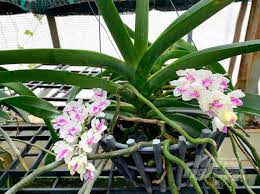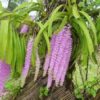# Symptoms of Nutrient Deficiency in Da Châu Orchids: Identification and Solutions

Da Châu orchids (*Rhynchostylis gigantea*), renowned for their striking blooms and unique growing habits, require careful attention to their nutritional needs to thrive. Like all plants, they rely on a balanced supply of essential nutrients to support their growth, flowering, and overall health. Understanding the symptoms of nutrient deficiencies is crucial for any orchid enthusiast. This comprehensive guide will explore the signs of nutrient deficiency in Da Châu orchids, the importance of each nutrient, and practical solutions to ensure these beautiful plants flourish.
## 1. Introduction to Da Châu Orchids
### 1.1 Botanical Overview
Da Châu orchids are epiphytic orchids native to Southeast Asia, particularly found in the regions of Thailand and Vietnam. They are characterized by their elongated, green leaves and fragrant, colorful flowers that can range from white and pink to purple and yellow. These orchids are often cultivated for their ornamental value and are popular in both indoor and outdoor settings.
### 1.2 Importance of Nutrients
Nutrients play a vital role in the growth and development of orchids. They contribute to processes such as photosynthesis, root development, and flower production. A deficiency in any of these essential nutrients can lead to poor health, stunted growth, and reduced flowering. Understanding how to recognize these deficiencies will help orchid growers maintain vibrant and healthy Da Châu orchids.
## 2. Essential Nutrients for Da Châu Orchids
Da Châu orchids require a variety of macro and micronutrients to thrive. Here’s an overview of the essential nutrients and their roles:
### 2.1 Macronutrients
1. **Nitrogen (N)**: Vital for leaf growth and overall plant vigor, nitrogen is crucial for chlorophyll production, which facilitates photosynthesis.
2. **Phosphorus (P)**: Important for root development, flower formation, and energy transfer within the plant. Phosphorus is essential during the early stages of growth and for blooming.
3. **Potassium (K)**: Plays a key role in water regulation, enzyme activation, and overall plant health. It helps strengthen plant tissues and improves resistance to diseases and environmental stress.
### 2.2 Secondary Nutrients
1. **Calcium (Ca)**: Important for cell wall structure and stability, calcium promotes root and leaf growth.
2. **Magnesium (Mg)**: A central component of chlorophyll, magnesium is essential for photosynthesis and influences nutrient uptake.
### 2.3 Micronutrients
1. **Iron (Fe)**: Necessary for chlorophyll synthesis and overall plant metabolism, iron deficiency can lead to yellowing leaves.
2. **Manganese (Mn)**, **Zinc (Zn)**, **Copper (Cu)**, **Boron (B)**: These micronutrients are involved in various biochemical processes, including photosynthesis, enzyme function, and hormone production.
## 3. Symptoms of Nutrient Deficiency in Da Châu Orchids
Recognizing the signs of nutrient deficiencies is crucial for timely intervention. Here are the symptoms associated with deficiencies in specific nutrients:
### 3.1 Nitrogen Deficiency
#### Symptoms
– **Yellowing Leaves**: The lower leaves may turn yellow and eventually drop off, while the upper leaves remain green.
– **Stunted Growth**: Overall growth slows down, resulting in smaller leaves and fewer blooms.
#### Causes
Nitrogen deficiency can occur due to infrequent fertilization or poor-quality potting media that lacks essential nutrients.
### 3.2 Phosphorus Deficiency
#### Symptoms
– **Dark Green or Purplish Leaves**: Older leaves may develop a dark green hue or purplish tint, particularly along the edges.
– **Poor Flower Development**: Buds may not develop properly, resulting in fewer or smaller flowers.
#### Causes
Insufficient phosphorus often arises from poor-quality fertilizers or improper soil pH, which can inhibit phosphorus uptake.
### 3.3 Potassium Deficiency
#### Symptoms
– **Leaf Tip Burn**: The tips of older leaves may turn brown and crispy, indicating a lack of potassium.
– **Weak Flower Stems**: Flower stems may be thin and weak, making them prone to breakage.
#### Causes
Potassium deficiency can result from leaching due to excessive watering or the use of low-quality fertilizers.
### 3.4 Calcium Deficiency
#### Symptoms
– **Leaf Curling**: New leaves may appear distorted or curled.
– **Root Issues**: Weak root development can lead to poor nutrient uptake and overall plant health.
#### Causes
Calcium deficiency may occur in acidic potting mixes or when using water with high salinity.
### 3.5 Magnesium Deficiency
#### Symptoms
– **Interveinal Chlorosis**: The area between leaf veins turns yellow while the veins remain green, leading to a mottled appearance.
– **Leaf Drop**: Older leaves may drop prematurely.
#### Causes
Magnesium deficiency can result from using fertilizers that lack magnesium or from high soil acidity.
### 3.6 Iron Deficiency
#### Symptoms
– **Chlorosis in Young Leaves**: Young leaves turn yellow while veins remain green, often starting at the tips.
– **Reduced Growth**: The overall growth of the orchid may slow down, leading to smaller leaves.
#### Causes
Iron deficiency is commonly caused by high pH levels in the soil, which can inhibit iron availability.
## 4. Diagnosing Nutrient Deficiencies
### 4.1 Visual Inspection
Conduct regular visual inspections of your Da Châu orchids. Look for changes in leaf color, size, and overall plant vigor. Note any specific patterns of discoloration, leaf drop, or other abnormalities.
### 4.2 Soil Testing
Consider conducting a soil test to determine the nutrient levels in your potting mix. This can help identify specific deficiencies and inform your fertilization strategy.
### 4.3 Adjusting Watering Practices
Overwatering or underwatering can exacerbate nutrient deficiencies. Ensure your watering practices are aligned with the needs of Da Châu orchids, allowing the potting mix to dry slightly between waterings.
## 5. Solutions for Nutrient Deficiencies
### 5.1 Fertilization Practices
1. **Use Balanced Fertilizers**: Select a high-quality, balanced orchid fertilizer with an appropriate N-P-K ratio. A ratio like 30-10-10 can provide a good balance of nutrients for orchids in growth and blooming phases.
2. **Frequency of Application**: Apply fertilizer every 2-4 weeks during the growing season (spring and summer) and reduce frequency during the dormant season (fall and winter).
3. **Dilution**: Always dilute fertilizer to half-strength to prevent burning the roots. Follow manufacturer instructions for specific products.
### 5.2 Adjusting pH Levels
– **Acidifying Agents**: If soil pH is too high, consider adding sulfur or other acidifying agents to improve nutrient availability. A pH of 5.5 to 6.5 is ideal for most orchids.
– **Testing Kits**: Use soil testing kits to monitor pH levels regularly and make necessary adjustments.
### 5.3 Improving Soil Quality
1. **Quality Potting Mix**: Use a high-quality orchid potting mix that provides good aeration and drainage. Look for mixes that include materials like bark, sphagnum moss, or perlite.
2. **Repotting**: If your potting mix is degraded or compacted, consider repotting your orchids into fresh mix to improve nutrient availability and root health.
### 5.4 Watering Techniques
– **Rainwater Collection**: Use rainwater for irrigation when possible. It is typically free of chlorine and other chemicals, providing a healthier option for your orchids.
– **Water Quality**: If using tap water, let it sit for 24 hours to allow chlorine to evaporate before watering your orchids.
## 6. Maintaining Optimal Growing Conditions
### 6.1 Light Requirements
Da Châu orchids thrive in bright, indirect light. Ensure they receive adequate light without direct sunlight, which can scorch their leaves. If necessary, adjust their location or use shade cloth to filter light.
### 6.2 Humidity Control
Maintain humidity levels between 50% and 80% to support healthy growth. Consider using humidity trays or misting the orchids regularly, especially during dry seasons.
### 6.3 Temperature Regulation
Ideal temperature ranges for Da Châu orchids are between 18°C to 30°C (65°F to 86°F). Avoid exposing them to extreme temperature fluctuations, which can stress the plants and lead to nutrient deficiencies.
## 7. Monitoring and Adjusting Care
### 7.1 Regular Observation
Keep a close eye on your orchids and note any changes in their appearance. Early detection of nutrient deficiencies will allow for prompt corrective actions.
### 7.2 Record Keeping
Maintain a care journal to track your watering, fertilization, and environmental conditions. This will help identify patterns and make necessary adjustments to your care routine.
### 7.3 Consult Resources
Utilize resources such as orchid care guides, gardening books, and online forums to expand your knowledge about Da Châu orchids and their care. Connecting with other orchid enthusiasts can also provide valuable insights.
## 8. Conclusion
Understanding the symptoms of nutrient deficiencies in Da Châu orchids is essential for ensuring their health and vitality. By recognizing the signs of deficiencies and implementing effective care strategies, orchid growers can promote robust growth and stunning blooms. Regular observation, proper fertilization, and maintaining optimal growing conditions will create a thriving environment for Da Châu orchids.
With diligence and attention to their nutritional needs, you can enjoy the beauty of these exquisite orchids for years to come. Remember, a healthy orchid not only enhances your space with its vibrant flowers but also brings joy and satisfaction to every orchid enthusiast.

